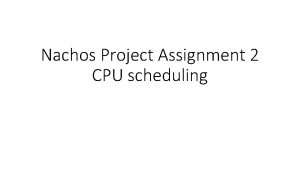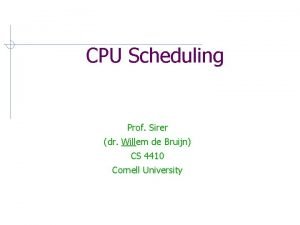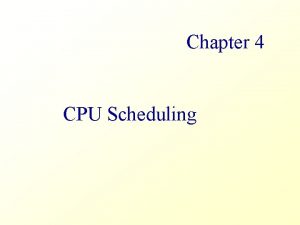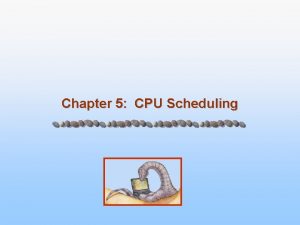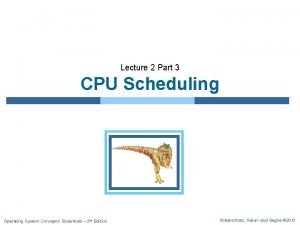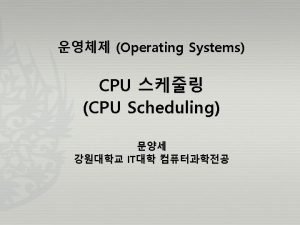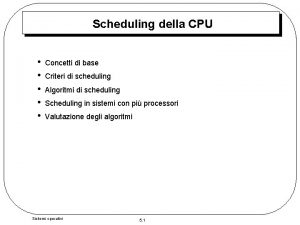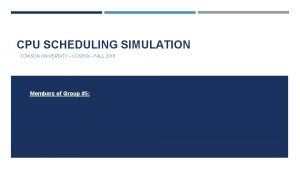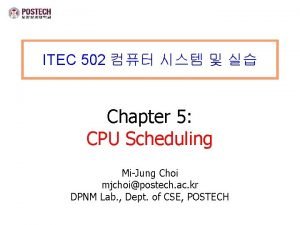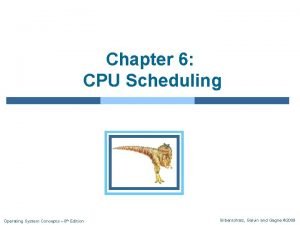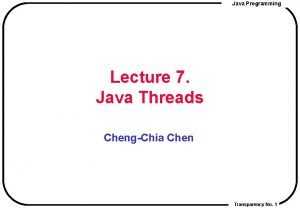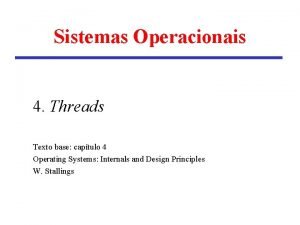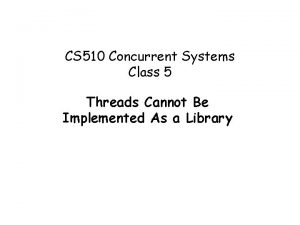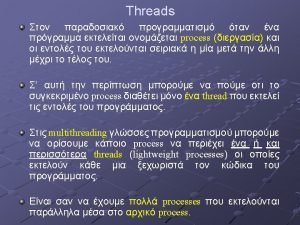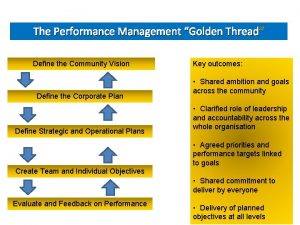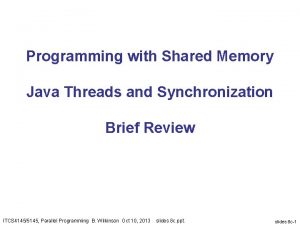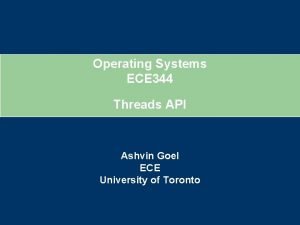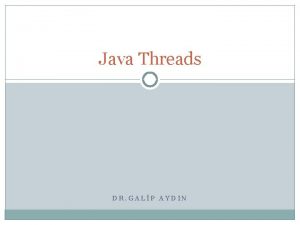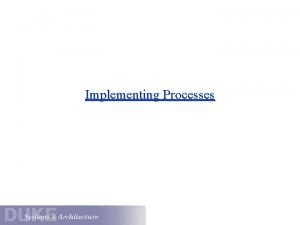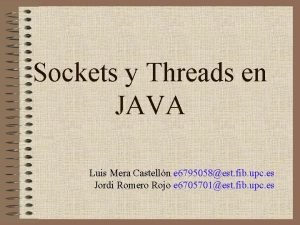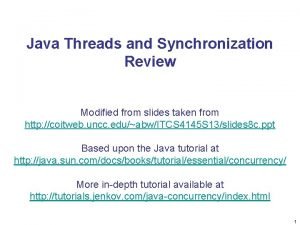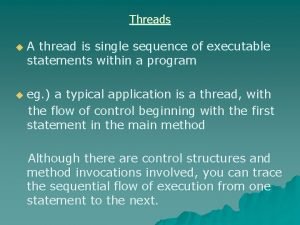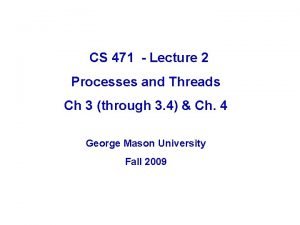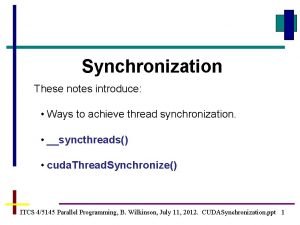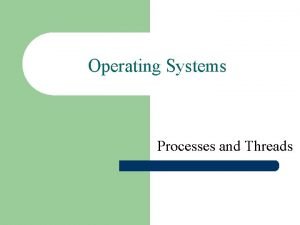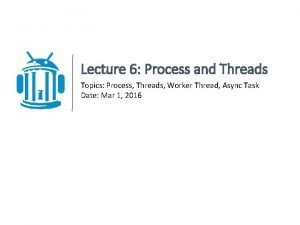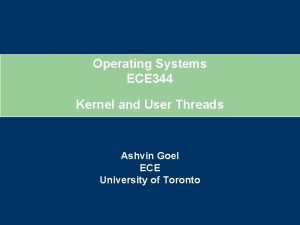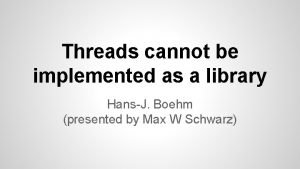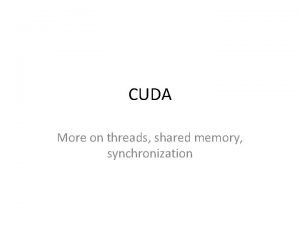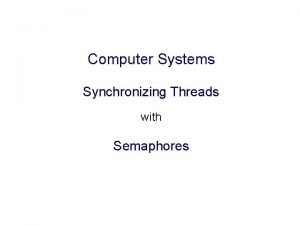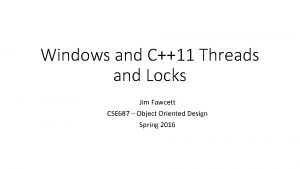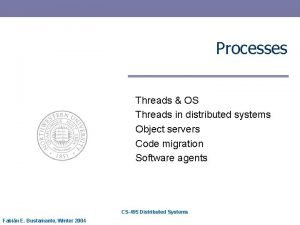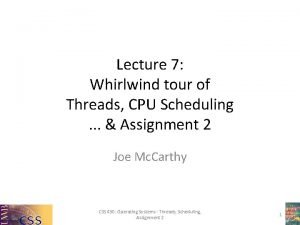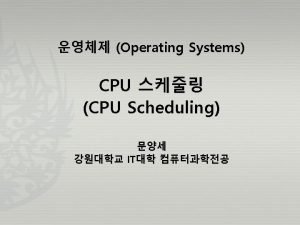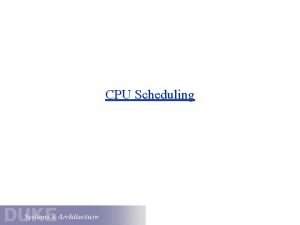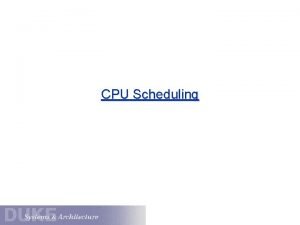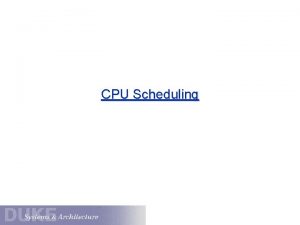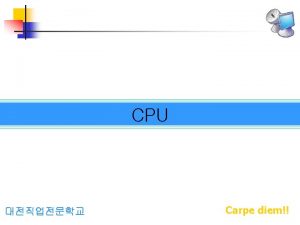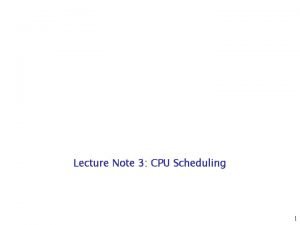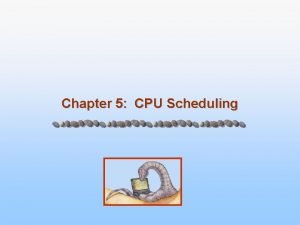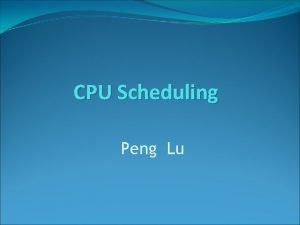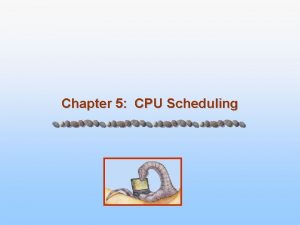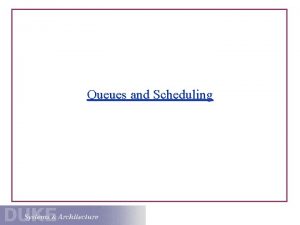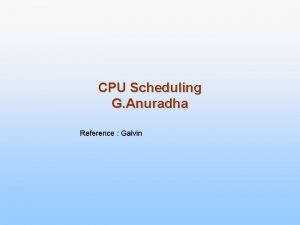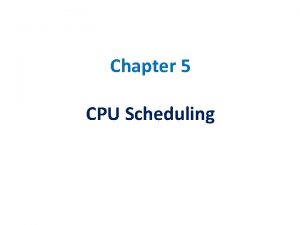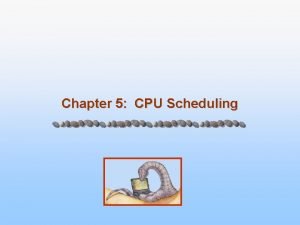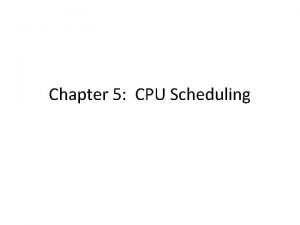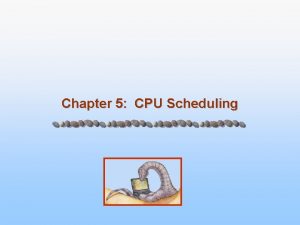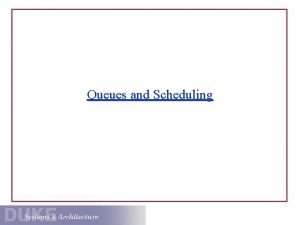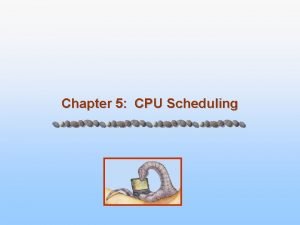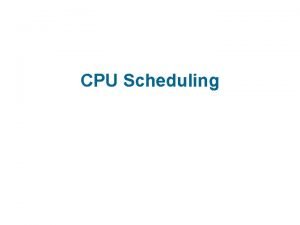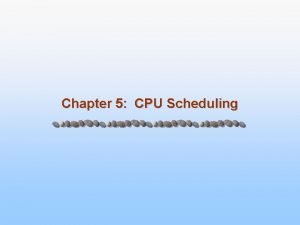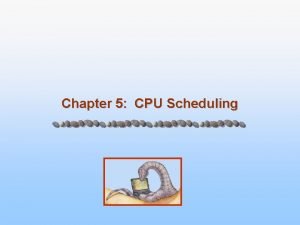Lecture 7 Whirlwind tour of Threads CPU Scheduling





![Chapter 4: Threads [selected excerpts] CSS 430: Operating Systems - Threads, Scheduling, Assignment 2 Chapter 4: Threads [selected excerpts] CSS 430: Operating Systems - Threads, Scheduling, Assignment 2](https://slidetodoc.com/presentation_image/2ee72b72a552580659f01f6766677a67/image-6.jpg)











![Chapter 5: CPU Scheduling [selected excerpts] CSS 430: Operating Systems - Threads, Scheduling, Assignment Chapter 5: CPU Scheduling [selected excerpts] CSS 430: Operating Systems - Threads, Scheduling, Assignment](https://slidetodoc.com/presentation_image/2ee72b72a552580659f01f6766677a67/image-18.jpg)
![CPU [from Chapter 1: Introduction] CSS 430: Operating Systems - Threads, Scheduling, Assignment 2 CPU [from Chapter 1: Introduction] CSS 430: Operating Systems - Threads, Scheduling, Assignment 2](https://slidetodoc.com/presentation_image/2ee72b72a552580659f01f6766677a67/image-19.jpg)
![CPU [from Chapter 1: Introduction] CSS 430: Operating Systems - Threads, Scheduling, Assignment 2 CPU [from Chapter 1: Introduction] CSS 430: Operating Systems - Threads, Scheduling, Assignment 2](https://slidetodoc.com/presentation_image/2ee72b72a552580659f01f6766677a67/image-20.jpg)
![CPU Scheduling [from Chapter 1: Introduction] CSS 430: Operating Systems - Threads, Scheduling, Assignment CPU Scheduling [from Chapter 1: Introduction] CSS 430: Operating Systems - Threads, Scheduling, Assignment](https://slidetodoc.com/presentation_image/2ee72b72a552580659f01f6766677a67/image-21.jpg)
![CPU Scheduling Multiprogramming [from Chapter 1: Introduction] CSS 430: Operating Systems - Threads, Scheduling, CPU Scheduling Multiprogramming [from Chapter 1: Introduction] CSS 430: Operating Systems - Threads, Scheduling,](https://slidetodoc.com/presentation_image/2ee72b72a552580659f01f6766677a67/image-22.jpg)
![CPU Scheduling [from Chapter 3: Processes] CSS 430: Operating Systems - Threads, Scheduling, Assignment CPU Scheduling [from Chapter 3: Processes] CSS 430: Operating Systems - Threads, Scheduling, Assignment](https://slidetodoc.com/presentation_image/2ee72b72a552580659f01f6766677a67/image-23.jpg)
![CPU Scheduling Process Control Blocks [from Chapter 3: Processes] CSS 430: Operating Systems - CPU Scheduling Process Control Blocks [from Chapter 3: Processes] CSS 430: Operating Systems -](https://slidetodoc.com/presentation_image/2ee72b72a552580659f01f6766677a67/image-24.jpg)
![CPU Scheduling Can all PCBs have access to CPU simultaneously? [from Chapter 3: Processes] CPU Scheduling Can all PCBs have access to CPU simultaneously? [from Chapter 3: Processes]](https://slidetodoc.com/presentation_image/2ee72b72a552580659f01f6766677a67/image-25.jpg)
![CPU Scheduling [from Chapter 3: Processes] CSS 430: Operating Systems - Threads, Scheduling, Assignment CPU Scheduling [from Chapter 3: Processes] CSS 430: Operating Systems - Threads, Scheduling, Assignment](https://slidetodoc.com/presentation_image/2ee72b72a552580659f01f6766677a67/image-26.jpg)
![CPU Queues [from Chapter 3: Processes] CSS 430: Operating Systems - Threads, Scheduling, Assignment CPU Queues [from Chapter 3: Processes] CSS 430: Operating Systems - Threads, Scheduling, Assignment](https://slidetodoc.com/presentation_image/2ee72b72a552580659f01f6766677a67/image-27.jpg)
![Process States [from Chapter 3: Processes] CSS 430: Operating Systems - Threads, Scheduling, Assignment Process States [from Chapter 3: Processes] CSS 430: Operating Systems - Threads, Scheduling, Assignment](https://slidetodoc.com/presentation_image/2ee72b72a552580659f01f6766677a67/image-28.jpg)






























- Slides: 58

Lecture 7: Whirlwind tour of Threads, CPU Scheduling. . . & Assignment 2 Joe Mc. Carthy CSS 430: Operating Systems - Threads, Scheduling, Assignment 2 1

Outline • Potentially helpful hints – execlp( “cat”, NULL ), testpipe 3. cpp – /usr/apps/CSS 430/examples • Selected excerpts from – Chapter 4: Threads – Chapter 5: CPU Scheduling • Assignment 2 • Next time: – Finish Chapters 4 & 5 CSS 430: Operating Systems - Threads, Scheduling, Assignment 2 2

Hint re: no output • Substitute execlp( “cat”, NULL ) for last stage of pipeline • If output comes through, problem is in that last stage • If output does not come through, substitute “cat” for next-to-last stage of pipeline • If output comes through, problem is in that stage • If no output comes through, problem is in first stage (or elsewhere) CSS 430: Operating Systems - Threads, Scheduling, Assignment 2 3

Hint re: hanging • testpipe 3. cpp • uw 1 -320 -lab: /usr/apps/CSS 430/examples • Uses • fork(), pipe(), dup 2() • echo, cat • Designed to • Echo it’s first argument through a pipe […]$. /testpipe 3 hello • … and then hang CSS 430: Operating Systems - Threads, Scheduling, Assignment 2 4

/* includes omitted from this excerpt */ int main( int argc, char** argv ) { int fd[2]; int pid; // only need one pid (why? ) assert(argc == 2); if ( pipe(fd) < 0 ) { perror( "pipe" ); exit( EXIT_FAILURE ); } else if ( ( pid = fork() ) < 0 ) { perror( "fork" ); exit( EXIT_FAILURE ); } else if ( pid > 0 ) { // this is the parent wait( NULL ); exit( EXIT_SUCCESS ); } else if ( ( pid = fork() ) < 0 ) { perror( "fork" ); exit( EXIT_FAILURE ); } else if ( pid > 0 ) { // this is [still] the child dup 2( fd[0], 0 ); // copy read-end of pipe to STDIN close( fd[1] ); // close write-end of pipe (not needed) execlp( "cat", NULL ); } else { // this is the grand-child close( fd[0] ); // close read-end of pipe (not needed) dup 2( fd[1], 1 ); // copy write-end of pipe to STDOUT execlp( "echo", argv[1], NULL ); } } CSS 430: Operating Systems - Threads, Scheduling, Assignment 2 5
![Chapter 4 Threads selected excerpts CSS 430 Operating Systems Threads Scheduling Assignment 2 Chapter 4: Threads [selected excerpts] CSS 430: Operating Systems - Threads, Scheduling, Assignment 2](https://slidetodoc.com/presentation_image/2ee72b72a552580659f01f6766677a67/image-6.jpg)
Chapter 4: Threads [selected excerpts] CSS 430: Operating Systems - Threads, Scheduling, Assignment 2 6

Single and Multithreaded Processes CSS 430: Operating Systems - Threads, Scheduling, Assignment 2 7

Multithreaded Server Architecture CSS 430: Operating Systems - Threads, Scheduling, Assignment 2 8

User Threads • Thread management done by user-level threads library • Three primary thread libraries: – POSIX Pthreads – Win 32 threads – Java threads CSS 430: Operating Systems - Threads, Scheduling, Assignment 2 9

Thread Libraries • Thread library provides programmer with API for creating and managing threads • Two primary ways of implementing – Library entirely in user space – Kernel-level library supported by the OS CSS 430: Operating Systems - Threads, Scheduling, Assignment 2 10

Java Thread States CSS 430: Operating Systems - Threads, Scheduling, Assignment 2 11

Java Threads • Java threads are managed by the JVM – 1 process, 1+ threads • Java threads may be created by: – Extending the Thread class • http: //download. oracle. com/javase/6/docs/api/java/lang/Thread. htm l – Implementing the Runnable interface • http: //download. oracle. com/javase/6/docs/api/java/lang/Runnable. h tml public class My. Shell extends Thread { … void run() { } } /usr/apps/CSS 430/examples/threads CSS 430: Operating Systems - Threads, Scheduling, Assignment 2 12

Java Threads - Producer-Consumer • Main driver: Factory. java – Shared memory via queue variable – Instantiates & starts 2 Threads import java. util. Date; public class Factory { public static void main( String[] args ) { // create the message queue Channel<Date> queue = new Message. Queue<Date>(); // create the producer and consumer threads Thread producer = new Thread( new Producer(queue) ); Thread consumer = new Thread( new Consumer(queue) ); // start the threads producer. start(); consumer. start(); } } /usr/apps/CSS 430/examples/threads CSS 430: Operating Systems - Threads, Scheduling, Assignment 2 13

Java Threads - Producer-Consumer • Shared memory via abstract data type: Channel. java public interface Channel<E> { public void send(E item); public E receive(); } /usr/apps/CSS 430/examples/threads CSS 430: Operating Systems - Threads, Scheduling, Assignment 2 14

Java Threads - Producer-Consumer • Implementation of abstract data type: Message. Queue. java import java. util. Vector; public class Message. Queue<E> implements Channel<E> { private Vector<E> queue; public Message. Queue() { queue = new Vector<E>(); } public void send( E item ) { queue. add. Element( item ); // add to tail (end) } public E receive() { if ( queue. size() == 0 ) return null; else // remove from head (front) return queue. remove( 0 ); } } /usr/apps/CSS 430/examples/threads CSS 430: Operating Systems - Threads, Scheduling, Assignment 2 15

Java Threads - Producer-Consumer /usr/apps/CSS 430/examples/threads CSS 430: Operating Systems - Threads, Scheduling, Assignment 2 16

Java Threads - Producer-Consumer /usr/apps/CSS 430/examples/threads CSS 430: Operating Systems - Threads, Scheduling, Assignment 2 17
![Chapter 5 CPU Scheduling selected excerpts CSS 430 Operating Systems Threads Scheduling Assignment Chapter 5: CPU Scheduling [selected excerpts] CSS 430: Operating Systems - Threads, Scheduling, Assignment](https://slidetodoc.com/presentation_image/2ee72b72a552580659f01f6766677a67/image-18.jpg)
Chapter 5: CPU Scheduling [selected excerpts] CSS 430: Operating Systems - Threads, Scheduling, Assignment 2 18
![CPU from Chapter 1 Introduction CSS 430 Operating Systems Threads Scheduling Assignment 2 CPU [from Chapter 1: Introduction] CSS 430: Operating Systems - Threads, Scheduling, Assignment 2](https://slidetodoc.com/presentation_image/2ee72b72a552580659f01f6766677a67/image-19.jpg)
CPU [from Chapter 1: Introduction] CSS 430: Operating Systems - Threads, Scheduling, Assignment 2 19
![CPU from Chapter 1 Introduction CSS 430 Operating Systems Threads Scheduling Assignment 2 CPU [from Chapter 1: Introduction] CSS 430: Operating Systems - Threads, Scheduling, Assignment 2](https://slidetodoc.com/presentation_image/2ee72b72a552580659f01f6766677a67/image-20.jpg)
CPU [from Chapter 1: Introduction] CSS 430: Operating Systems - Threads, Scheduling, Assignment 2 20
![CPU Scheduling from Chapter 1 Introduction CSS 430 Operating Systems Threads Scheduling Assignment CPU Scheduling [from Chapter 1: Introduction] CSS 430: Operating Systems - Threads, Scheduling, Assignment](https://slidetodoc.com/presentation_image/2ee72b72a552580659f01f6766677a67/image-21.jpg)
CPU Scheduling [from Chapter 1: Introduction] CSS 430: Operating Systems - Threads, Scheduling, Assignment 2 21
![CPU Scheduling Multiprogramming from Chapter 1 Introduction CSS 430 Operating Systems Threads Scheduling CPU Scheduling Multiprogramming [from Chapter 1: Introduction] CSS 430: Operating Systems - Threads, Scheduling,](https://slidetodoc.com/presentation_image/2ee72b72a552580659f01f6766677a67/image-22.jpg)
CPU Scheduling Multiprogramming [from Chapter 1: Introduction] CSS 430: Operating Systems - Threads, Scheduling, Assignment 2 22
![CPU Scheduling from Chapter 3 Processes CSS 430 Operating Systems Threads Scheduling Assignment CPU Scheduling [from Chapter 3: Processes] CSS 430: Operating Systems - Threads, Scheduling, Assignment](https://slidetodoc.com/presentation_image/2ee72b72a552580659f01f6766677a67/image-23.jpg)
CPU Scheduling [from Chapter 3: Processes] CSS 430: Operating Systems - Threads, Scheduling, Assignment 2 23
![CPU Scheduling Process Control Blocks from Chapter 3 Processes CSS 430 Operating Systems CPU Scheduling Process Control Blocks [from Chapter 3: Processes] CSS 430: Operating Systems -](https://slidetodoc.com/presentation_image/2ee72b72a552580659f01f6766677a67/image-24.jpg)
CPU Scheduling Process Control Blocks [from Chapter 3: Processes] CSS 430: Operating Systems - Threads, Scheduling, Assignment 2 24
![CPU Scheduling Can all PCBs have access to CPU simultaneously from Chapter 3 Processes CPU Scheduling Can all PCBs have access to CPU simultaneously? [from Chapter 3: Processes]](https://slidetodoc.com/presentation_image/2ee72b72a552580659f01f6766677a67/image-25.jpg)
CPU Scheduling Can all PCBs have access to CPU simultaneously? [from Chapter 3: Processes] CSS 430: Operating Systems - Threads, Scheduling, Assignment 2 25
![CPU Scheduling from Chapter 3 Processes CSS 430 Operating Systems Threads Scheduling Assignment CPU Scheduling [from Chapter 3: Processes] CSS 430: Operating Systems - Threads, Scheduling, Assignment](https://slidetodoc.com/presentation_image/2ee72b72a552580659f01f6766677a67/image-26.jpg)
CPU Scheduling [from Chapter 3: Processes] CSS 430: Operating Systems - Threads, Scheduling, Assignment 2 26
![CPU Queues from Chapter 3 Processes CSS 430 Operating Systems Threads Scheduling Assignment CPU Queues [from Chapter 3: Processes] CSS 430: Operating Systems - Threads, Scheduling, Assignment](https://slidetodoc.com/presentation_image/2ee72b72a552580659f01f6766677a67/image-27.jpg)
CPU Queues [from Chapter 3: Processes] CSS 430: Operating Systems - Threads, Scheduling, Assignment 2 27
![Process States from Chapter 3 Processes CSS 430 Operating Systems Threads Scheduling Assignment Process States [from Chapter 3: Processes] CSS 430: Operating Systems - Threads, Scheduling, Assignment](https://slidetodoc.com/presentation_image/2ee72b72a552580659f01f6766677a67/image-28.jpg)
Process States [from Chapter 3: Processes] CSS 430: Operating Systems - Threads, Scheduling, Assignment 2 28

Basic Concepts • Goal: Maximize CPU utilization via optimized multiprogramming • CPU–I/O Burst Cycle: – Process execution consists of a cycle of • CPU execution • I/O wait • CPU burst durations vary – Within a process, across different processes CSS 430: Operating Systems - Threads, Scheduling, Assignment 2 29

Histogram of CPU-burst Durations CSS 430: Operating Systems - Threads, Scheduling, Assignment 2 30

Alternating Sequence of CPU & I/O Bursts CSS 430: Operating Systems - Threads, Scheduling, Assignment 2 31

CPU Scheduler • Selects next process to run (i. e. , to get CPU time) • Dispatches that process (allocates the CPU to it) • CPU scheduler called when a process … CSS 430: Operating Systems - Threads, Scheduling, Assignment 2 32

CPU Scheduler • Selects next process to run (i. e. , to get CPU time) • Dispatches that process (allocates the CPU to it) • CPU scheduler called when a process: – Running terminated – Running waiting – Running ready – Waiting ready • Preemptive vs. non-preemptive CSS 430: Operating Systems - Threads, Scheduling, Assignment 2 33

Dispatcher • Activates a process (gives control of the CPU to the process) selected by the short-term scheduler • Three steps: CSS 430: Operating Systems - Threads, Scheduling, Assignment 2 34

Dispatcher • Activates a process (gives control of the CPU to the process) selected by the short-term scheduler • Three steps: CSS 430: Operating Systems - Threads, Scheduling, Assignment 2 35

Dispatcher • Activates a process (gives control of the CPU to the process) selected by the short-term scheduler • Three steps: – Switch context – Switch to user mode – Jump to the proper location in user program to start/resume CSS 430: Operating Systems - Threads, Scheduling, Assignment 2 36

Dispatcher • Activates a process (gives control of the CPU to the process) selected by the short-term scheduler • Three steps: – Switch context – Switch to user mode – Jump to the proper location in user program to start/resume • Dispatch latency: time it takes for the dispatcher to stop one user process and start another one CSS 430: Operating Systems - Threads, Scheduling, Assignment 2 37

Scheduling Milestones • Submission Time – Time when job is submitted – E. g. , when command is entered in shell • Admission Time – Time when job is admitted to Ready queue – PCB creation & other housekeeping has to take place • Activation Time – Time when job is first activated – E. g. , when first output starts appearing on console – NB: may have several CPU-I/O burst cycles • Completion Time – Time when job finishes executing CSS 430: Operating Systems - Threads, Scheduling, Assignment 2 38

Job (Process/Thread) Times • Response Time – Time before job is first activated – Activation Time – Submission Time – E. g. , time between entering command & first response • Wait Time – Total amount of time a job spends in Ready queue • Execution Time – Total amount of time a job spends Running – NB: may have several CPU-I/O burst cycles • Turnaround Time – Time a job takes to complete after it is submitted – Completion Time – Submission Time – Response Time + Wait Time + Execution Time + I/O Time CSS 430: Operating Systems - Threads, Scheduling, Assignment 2 39

Scheduling Criteria • CPU utilization – % of time CPU is executing user processes • Throughput – # of processes that complete their execution per time unit • Average response time – average amount of between when a process is submitted & first response (for time-sharing environment) • Average waiting time – average amount of time a process waits in Ready queue • Average turnaround time – average amount of time to execute a process CSS 430: Operating Systems - Threads, Scheduling, Assignment 2 40

Scheduling Optimization Criteria • CPU utilization: maximize – % of time CPU is executing user processes • Throughput: maximize – # of processes that complete their execution per time unit • Average response time: minimize – average amount of between when a process is submitted & first response (for time-sharing environment) • Average waiting time: minimize – average amount of time a process waits in Ready queue • Average turnaround time: minimize – average amount of time to execute a process CSS 430: Operating Systems - Threads, Scheduling, Assignment 2 41

First-Come, First-Served (FCFS) • Example: 3 processes with the following burst times: – P 1 = 24; P 2 = 3; P 3 = 3 • Suppose that the processes arrive in the order: P 1, P 2, P 3 The Gantt Chart for the schedule is: P 1 0 P 2 24 P 3 27 30 • Waiting times? • Average waiting time? CSS 430: Operating Systems - Threads, Scheduling, Assignment 2 42

First-Come, First-Served (FCFS) • Example: 3 processes with the following burst times: – P 1 = 24; P 2 = 3; P 3 = 3 • Suppose that the processes arrive in the order: P 1, P 2, P 3 The Gantt Chart for the schedule is: P 1 0 P 2 24 P 3 27 30 • Waiting times: P 1 = 0; P 2 = 24; P 3 = 27 • Average waiting time: (0 + 24 + 27) / 3 = 17. 0 CSS 430: Operating Systems - Threads, Scheduling, Assignment 2 43

FCFS Scheduling (Cont. ) Suppose that the processes arrive in the order: P 2 , P 3 , P 1 • The Gantt chart for the schedule is: P 2 0 P 3 3 P 1 6 30 • Waiting times? • Average waiting times? CSS 430: Operating Systems - Threads, Scheduling, Assignment 2 44

FCFS Scheduling (Cont. ) Suppose that the processes arrive in the order: P 2 , P 3 , P 1 • The Gantt chart for the schedule is: P 2 0 • • P 3 3 P 1 6 30 Waiting times: P 1 = 6; P 2 = 0; ; P 3 = 3 Average waiting time: (6 + 0 + 3) / 3 = 3. 0 Much better than previous case Convoy effect short process behind long process CSS 430: Operating Systems - Threads, Scheduling, Assignment 2 45

Priority Scheduling • A priority number (integer) is associated with each process • The CPU is always allocated to the process with the highest priority • Two basic strategies: – Preemptive can interrupt current process, switch to new one – Nonpreemptive wait until current process finishes, then switch CSS 430: Operating Systems - Threads, Scheduling, Assignment 2 46

Round Robin (RR) • Each process gets a time quantum (q) of CPU time, usually 10 -100 milliseconds – Selected from front of Ready queue (priority = queue size – process position) • If process does not block (I/O) within q ms: preempted – Added to the end of the Ready queue • General observations: – n processes in the Ready queue – each process gets 1/n of the CPU time (in slices of size q) – no process waits more than (n-1)q time units CSS 430: Operating Systems - Threads, Scheduling, Assignment 2 47

Example of RR with Time Quantum = 4 Process P 1 P 2 P 3 Burst Time 24 3 3 • The Gantt chart is: P 1 0 P 2 4 P 3 7 P 1 10 P 1 14 P 1 18 22 P 1 26 CSS 430: Operating Systems - Threads, Scheduling, Assignment 2 P 1 30 48

Multilevel Queue • Ready queue can be partitioned into separate queues – E. g. , foreground (interactive) & background (batch) • Each queue can have its own scheduling algorithm • Scheduling must be done between the queues • Simplest: Fixed priority scheduling – One possibility: 100% priority to foreground • Serve foreground if any; serve background only if no foreground • Problem? CSS 430: Operating Systems - Threads, Scheduling, Assignment 2 49

Multilevel Queue • Ready queue can be partitioned into separate queues – E. g. , foreground (interactive) & background (batch) • Each queue can have its own scheduling algorithm • Scheduling must be done between the queues • Simplest: Fixed priority scheduling – One possibility: 100% priority to foreground • Serve foreground if any; serve background only if no foreground • Problem: possibility of starvation – Another possibility? CSS 430: Operating Systems - Threads, Scheduling, Assignment 2 50

Multilevel Queue • Ready queue can be partitioned into separate queues – E. g. , foreground (interactive) & background (batch) • Each queue can have its own scheduling algorithm • Scheduling must be done between the queues • Simplest: Fixed priority scheduling – One possibility: 100% priority to foreground • Serve foreground if any; serve background only if no foreground • Problem: possibility of starvation. – Another possibility: 80/20 priority using time slices • 80% to foreground using RR • 20% to background using FCFS CSS 430: Operating Systems - Threads, Scheduling, Assignment 2 51

Multilevel Queue Scheduling CSS 430: Operating Systems - Threads, Scheduling, Assignment 2 52

Multilevel Feedback Queue • Process can migrate among queues – Queue placement based on past behavior (feedback) • Multilevel feedback queue scheduler – Parameters? CSS 430: Operating Systems - Threads, Scheduling, Assignment 2 53

Multilevel Feedback Queue • Process can migrate among queues – Queue placement based on past behavior (feedback) • Multilevel feedback queue scheduler: – number of queues – scheduling algorithms for each queue – when to upgrade a process – when to demote a process – when to select a queue for service CSS 430: Operating Systems - Threads, Scheduling, Assignment 2 54

Multilevel Feedback Queue CSS 430: Operating Systems - Threads, Scheduling, Assignment 2 55

Example of Multilevel Feedback Queue • Three queues: Q 0, Q 1, Q 2; all use FCFS • If blocked for I/O, job returned to Q 0 when I/O done • New jobs enter queue Q 0 – When activated (given CPU), job receives 8 milliseconds – If not done, job is preempted, demoted to queue Q 1 • Jobs in Q 1 – When activated, job receives 16 additional milliseconds – If not done, job is preempted, demoted to Q 2 • Jobs in Q 2 – When activated, job runs until terminated or interrupted – If not done, job is preempted, returned to Q 2 CSS 430: Operating Systems - Threads, Scheduling, Assignment 2 56

Programming Assignment 2 Scheduler. java http: //courses. washington. edu/css 430/joemcc/prog 2 b. html CSS 430: Operating Systems - Threads, Scheduling, Assignment 2 57

For next time • Readings – Chapter 4: Threads – Chapter 5: CPU Scheduling CSS 430: Operating Systems - Threads, Scheduling, Assignment 2 58
 Job 38:22-30
Job 38:22-30 Was sally ann thunder ann whirlwind a real person
Was sally ann thunder ann whirlwind a real person Threads consumes cpu in best possible manner
Threads consumes cpu in best possible manner Tour escort jobs
Tour escort jobs Dangerous world tour setlist
Dangerous world tour setlist Tour eiffel c. tours petronas
Tour eiffel c. tours petronas Cpu scheduling project
Cpu scheduling project Sjf cpu scheduling
Sjf cpu scheduling Waiting time in cpu scheduling
Waiting time in cpu scheduling First come first serve gantt chart
First come first serve gantt chart A cpu scheduling algorithm determines an order
A cpu scheduling algorithm determines an order Turnaround time in os
Turnaround time in os Cpu i/o
Cpu i/o Scheduling della cpu
Scheduling della cpu Cpu scheduling project
Cpu scheduling project Multilevel queue scheduling
Multilevel queue scheduling Sjf cpu scheduling
Sjf cpu scheduling Sjn scheduling
Sjn scheduling 01:640:244 lecture notes - lecture 15: plat, idah, farad
01:640:244 lecture notes - lecture 15: plat, idah, farad A flexible flat material made by interlacing threads/fibers
A flexible flat material made by interlacing threads/fibers Chia number of threads
Chia number of threads Threads.h
Threads.h Threads cannot be implemented as a library
Threads cannot be implemented as a library Threads fiji
Threads fiji Vinaya pitaka is a sacred text of
Vinaya pitaka is a sacred text of Golden thread model
Golden thread model Java shared memory between threads
Java shared memory between threads Mission thread example
Mission thread example Qscheduler
Qscheduler Thread vs process
Thread vs process Threads java
Threads java Tipos de escalonamento
Tipos de escalonamento Threads vs processes
Threads vs processes The kernel is unaware of user threads
The kernel is unaware of user threads Sockets and threads
Sockets and threads Needle like threads of spongy bone
Needle like threads of spongy bone Pintos priority donation
Pintos priority donation Internal screw thread
Internal screw thread Threads em java
Threads em java What is thread in operating system
What is thread in operating system Sequence diagram threads
Sequence diagram threads Lathe machine mcq
Lathe machine mcq Osteospermum white lightning
Osteospermum white lightning Process and threads
Process and threads Scheduler activation
Scheduler activation Cuda synchronize threads
Cuda synchronize threads Posix threads
Posix threads Used to trim threads two handles same size
Used to trim threads two handles same size Slidetodoc.com
Slidetodoc.com Process and threads
Process and threads Ece threads
Ece threads Threads cannot be implemented as a library
Threads cannot be implemented as a library Cuprintf
Cuprintf Forum.unity.com/threads/game-over.54735
Forum.unity.com/threads/game-over.54735 Os threads
Os threads Pintos advanced scheduler
Pintos advanced scheduler Os threads
Os threads C11 threads
C11 threads Threads in distributed systems
Threads in distributed systems






